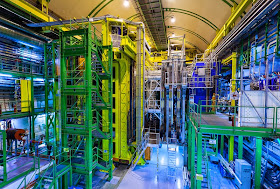CERN - European Organization for Nuclear Research logo.
March 21, 2015
Yesterday, at the 50th Moriond Electroweak conference (link is external) (La Thuile, Italy), LHCb physicists presented an analysis, which show deviations from Standard Model calculations.
The Standard Model describes elementary particles and their behaviour. Even though it is currently the best description there is of the subatomic world, it does not explain the complete picture. Some phenomena remain unexplained. That’s why theoreticians have developed models beyond the Standard Model, which would complete the picture. Experiments at the LHC are looking for hints of this “new physics”, which would include yet undiscovered particles.
Graphic above: The LHCb analysis presented at the Moriond Electroweak conference; the black points show the measurements released yesterday.
The LHCb (Large Hadron Collider beauty) experiment searches for new physics by looking for the effects of possible new particles in rare decays of B particles, particles that contain a beauty quark. These "indirect searches" allow them to probe mass scales inaccessible by other techniques.
In this search, LHCb physicists have been studying the angular distribution of the particles coming from one of these rare B particle decays (B → K*μμ), a parameter that is highly sensitive to the effects of new particles. "This decay is a laboratory on its own," said Patrick Koppenburg, LHCb Physics Coordinator. "Many of the particles that CERN experiments search for in their data can be studied in this decay."
In their analysis of the full LHC Run 1 data set, LHCb physicists found a local deviation from Standard Model calculations. The results confirm a previously published analysis using 2011 LHCb data.
These new results are certain to draw the attention of physicists worldwide, as theorists consider the many possible implications. Theoretical predictions of the Standard Model values (in orange on the graph) are also expected to be further improved.
CERN - Large Hadron Collider Beauty Experiment (LHCb) room
LHCb is an experiment set up to explore what happened after the Big Bang that allowed matter to survive and build the Universe we inhabit today.
Fourteen billion years ago, the Universe began with a bang. Crammed within an infinitely small space, energy coalesced to form equal quantities of matter and antimatter. But as the Universe cooled and expanded, its composition changed. Just one second after the Big Bang, antimatter had all but disappeared, leaving matter to form everything that we see around us — from the stars and galaxies, to the Earth and all life that it supports.
Read the full version of this article here: http://home.web.cern.ch/scientists/updates/2015/03/lhcbs-new-analysis-confirms-old-puzzle
Note:
CERN, the European Organization for Nuclear Research, is one of the world’s largest and most respected centres for scientific research. Its business is fundamental physics, finding out what the Universe is made of and how it works. At CERN, the world’s largest and most complex scientific instruments are used to study the basic constituents of matter — the fundamental particles. By studying what happens when these particles collide, physicists learn about the laws of Nature.
The instruments used at CERN are particle accelerators and detectors. Accelerators boost beams of particles to high energies before they are made to collide with each other or with stationary targets. Detectors observe and record the results of these collisions.
Founded in 1954, the CERN Laboratory sits astride the Franco–Swiss border near Geneva. It was one of Europe’s first joint ventures and now has 22 Member States.
Related links:
50th Moriond Electroweak conference: http://moriond.in2p3.fr/
The LHCb (Large Hadron Collider beauty) experiment: http://home.web.cern.ch/about/experiments/lhcb
The Standard Model: http://home.web.cern.ch/about/physics/standard-model
2011 LHCb data: http://lhcb-public.web.cern.ch/lhcb-public/Welcome.html#KstarMuMu3
For more information about the European Organization for Nuclear Research (CERN), visit: http://home.web.cern.ch/
Image, Graphic, Text, Credits: CERN / Katarina Anthony.
Greetings, Orbiter.ch







.jpg)


























.jpg)






.jpg)









